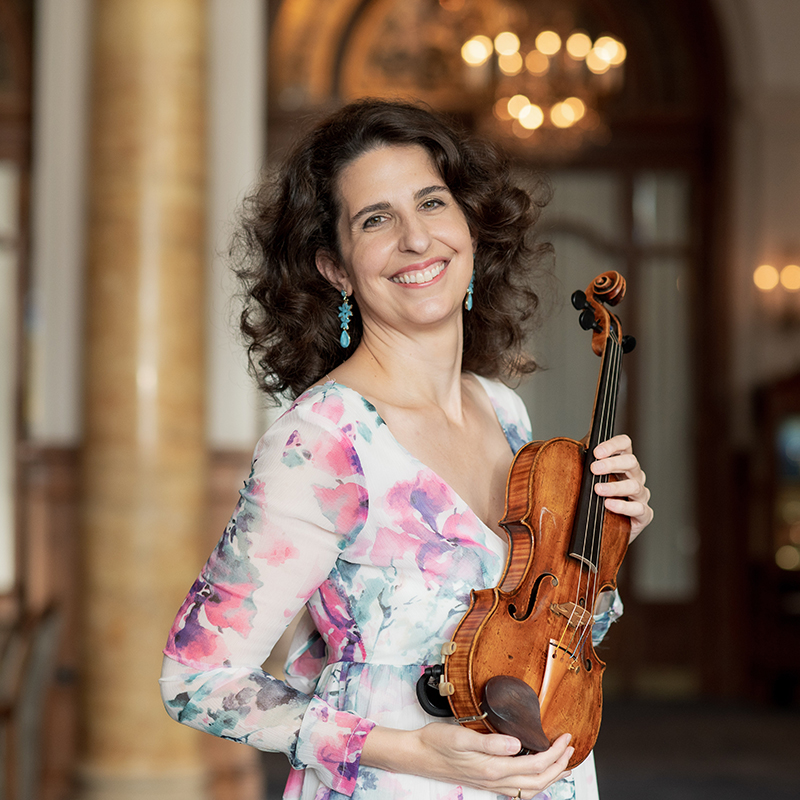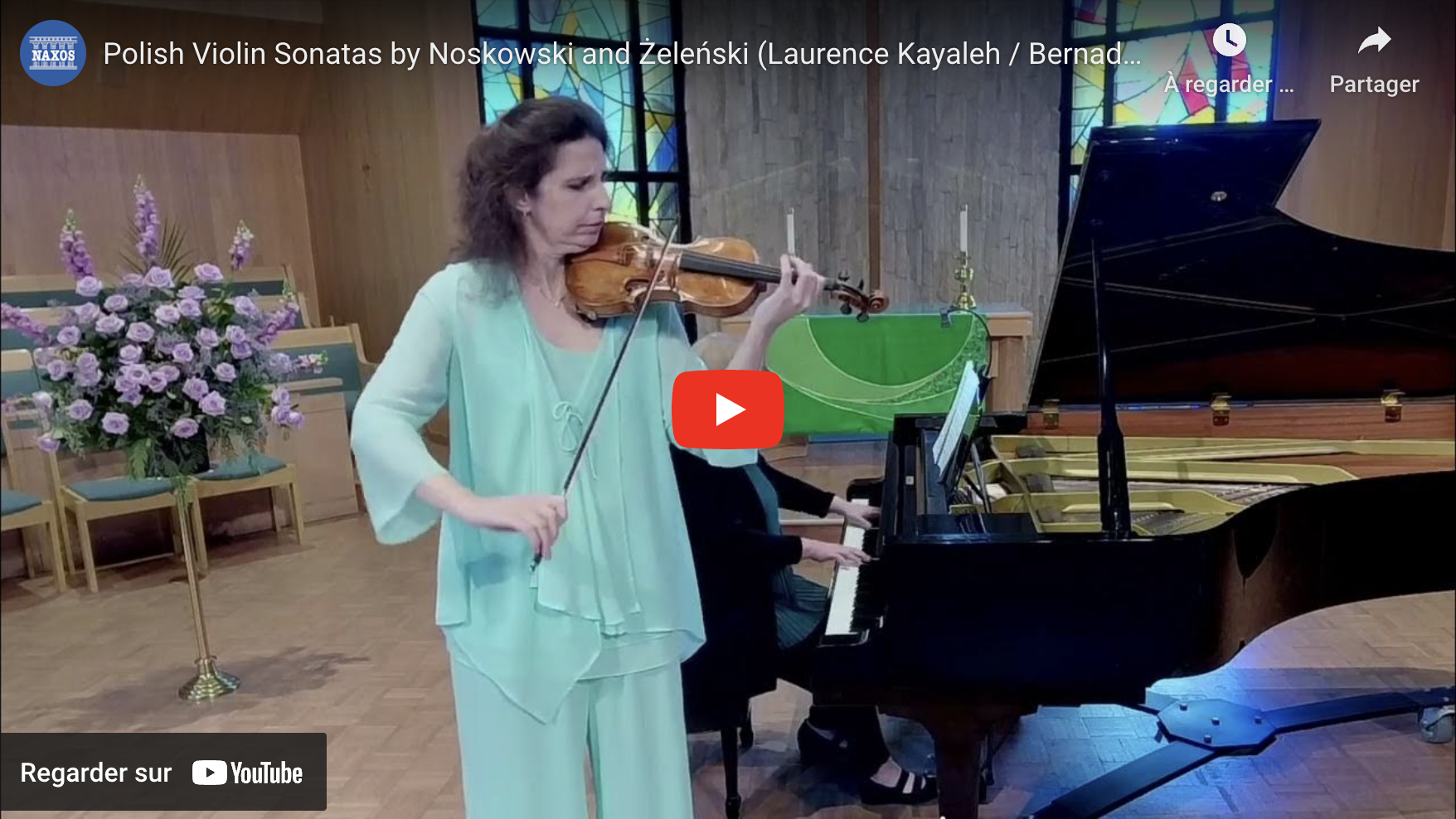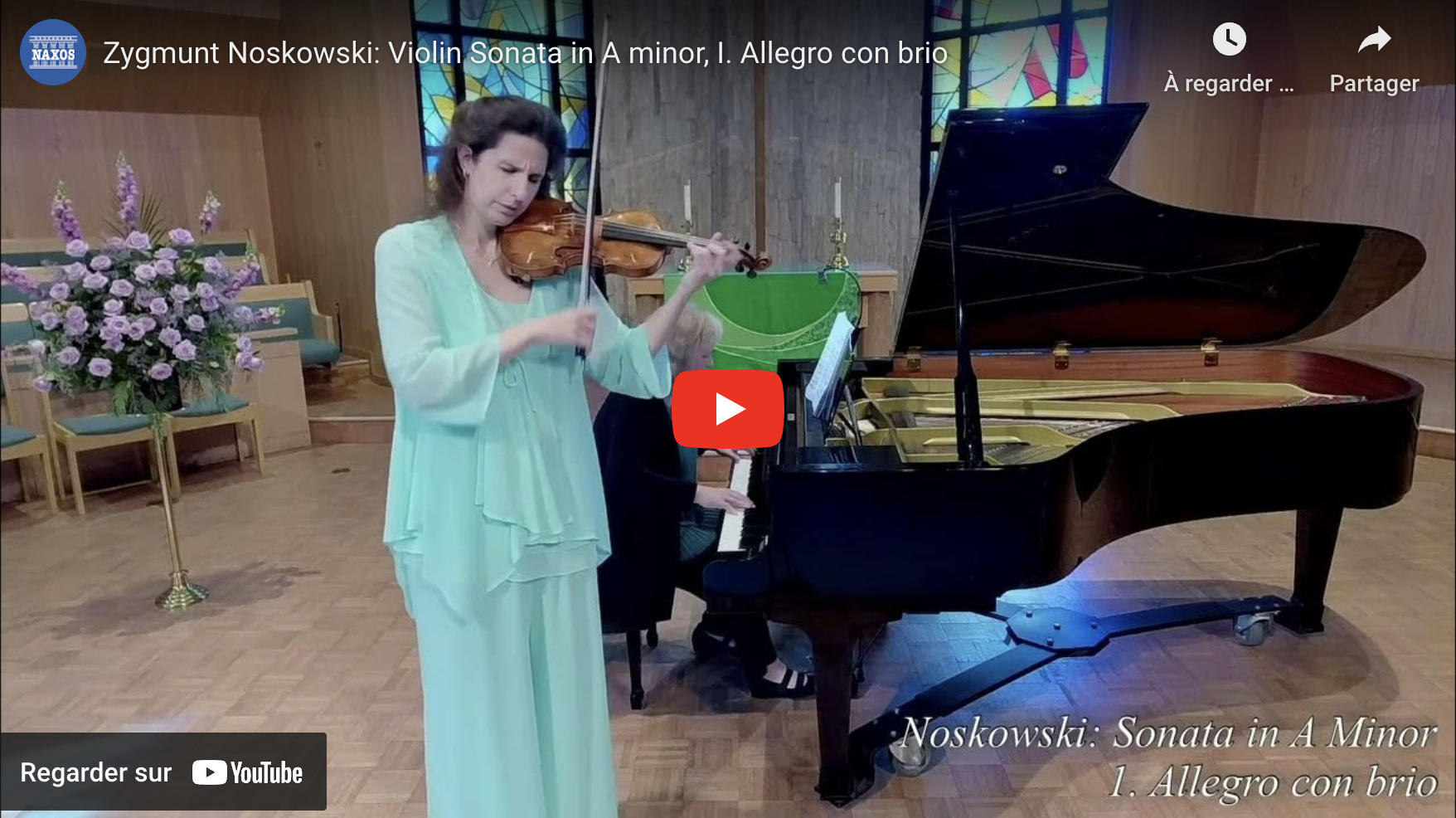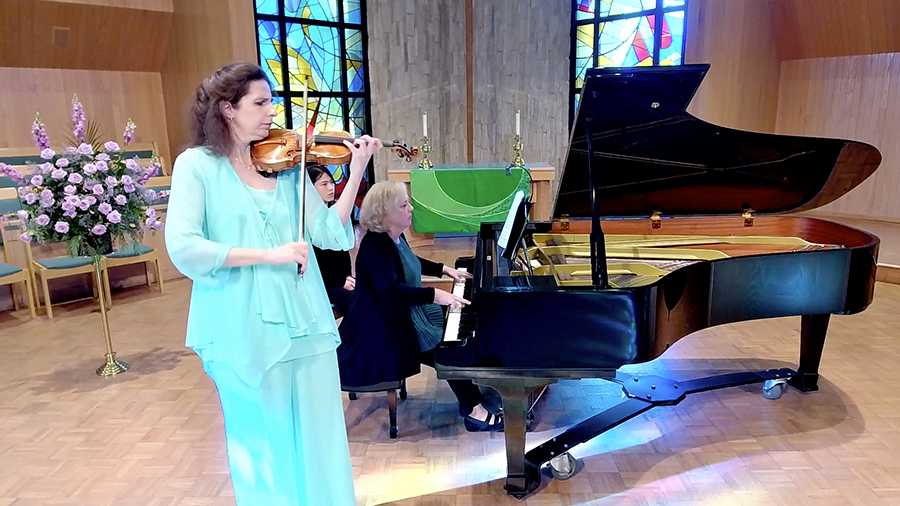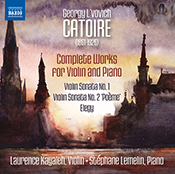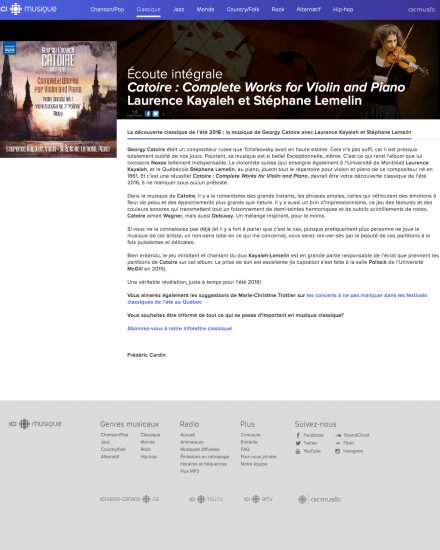Press Reviews
Le Dauphiné Libéré – July 2025
Fêtes musicales de Savoie, France (July 2025) – 35th Edition – Dauphiné Libéré
Le mardi 15 juillet à 18h30, plusieurs artistes donneront un concert aux notes de Bach en l’église. Il y aura Laurence Kayaleh, violoniste. Elle a commencé très tôt sa carrière, dans les centres de musique les plus prestigieux tels que ceux de Paris, Prague, Bruxelles. Elle a joué dans les plus grandes salles de concerts et sous la direction de chefs internationaux. Sa carrière américaine lui vaut de grandes ovations: à Cleveland avec le Cleveland orchestra et au John-F. Kennedy center for the performing arts à Washington, avec le National Symphonie Orchestra. Georges Kiss, claveciniste, sera aussi là. Il a décroché le Premier Prix avec distinction du Conservatoire supérieur de Genève. Il se passionne très tôt pour ce qui lui apparait comme les trois volets indissociables de la vocation de musicien : concerts, musicologie et pédagogie. Cet interprète a donné plus de 2000 concerts, a conduit dans la plupart des pays européens en soliste, en récital ou en formation de chambre, en Amérique et en Asie.

MusicWeb International – March 2024
NOSKOWSKI & ZELENSKI : VIOLIN SONATAS (Naxos Records 8.574220)
LAURENCE KAYALEH & BERNADENE BLAHA
“I have no complaints at all with the fine soloists, violinist Laurence Kayaleh and pianist Bernadene Blaha; both are passionate and fully immersed in the music, finding a marvellous blend in the quite intertwined parts. Both sonatas have previously been recorded on Acte Préalable, but I find Kayaleh’s tone much richer than either Jolanta Sosnowska in the Noszkowski (AP0248) or Gustaw Ciężarek (AP0238) and Barbara Trojanowski (AP0112) in the Żeleński. The latter recording makes heavy weather of the passage work, especially from pianist Elžbieta Tyszecka, something that is certainly not an issue with this fine Naxos partnership.”
March 2024 – MusicWeb INTERNATIONAL

The Strad – February 2024
Stirring readings of violin sonatas by two Polish nationalist composers
Musicians : Laurence Kayaleh (violin), Bernadene Blaha (piano)
Works : Noskowski: Violin Sonata in A minor. Želeński: Violin Sonata in F major op.30
Catalogue number : NAXOS 8.574220
These two Polish sonatas from the latter part of the 19th century are attractive, conservative in style, and well worth hearing. Zygmunt Noskowski’s A minor Sonata of the mid-1870s is brimming with melody and hints of Brahms. It opens with a somewhat severe dialogue before opening out into free-flowing lyricism, opulent and alluring, played by Laurence Kayaleh with full-toned warmth and fluency, with the pianist Bernadene Blaha often in busy attendance. The melodies continue to flow as the development becomes increasingly impassioned. Along the way Kayaleh produces some nicely turned moments of quiet questioning. The second movement is a set of variations on a genial, occasionally pensive, theme; as the variations progress Kayaleh is by turns light and sinuous, or tender and shapely, with a gentle, autumnal beauty to round them off. The final Prestissimo is a staccato dash in the nature of a tarantella, with both players exhibiting plenty of rhythmic energy.
In the first movement of Władysław Želeński’s slightly later F major Sonata, Kayaleh deals elegantly with some nifty runs and double-stops, with Blaha always excellent in the demanding piano writing. The central Allegretto has graceful playing of deceptive simplicity. The nearest the sonata gets to a slow movement is the Molto sostenuto opening of the finale, with Kayaleh sensitively outlining its twisting contours, before his ebullient playing of the Allegro. The recorded sound is resonant, with the piano sometimes sounding a little boxy.
February 2024 – The Strad

PAN M 360 – December 2023
NOSKOWSKI & ZELENSKI : VIOLIN SONATAS (Naxos Records 8.574220)
LAURENCE KAYALEH & BERNADENE BLAHA
Montreal violinist Laurence Kayaleh is no stranger to the lesser-known repertoire, thanks to several recordings on the Naxos label. We’ve heard her in sonatas by Medtner, Honegger, Raff, Catoire and Rebay, and this time she takes us even further into the shadows of the musical past with these two titles from Polish Romanticism. A rather ‘Germanophile’ Romanticism, that said, for both works betray an obvious debt to Beethoven and Brahms.
The Sonata in A minor by Zygmunt Noskowski (1846-1909) has all the makings of a Beethovenian work, especially the Kreutzer Sonata. Its main asset is the lively themes and a melodic vigour that is frankly very pleasing. Wladislaw Zelenski offers us a Sonata in F major, Op. 30, also rather conservative for its time, and therefore Beethovenian, but with an expressive breadth that also looks towards Brahms. Once again, while the style is largely borrowed, the melodies and their development are drawn with strength and inspiration, offering music lovers a very fine discovery that has character and arouses definite interest.
Laurence Kayaleh and pianist Bernadene Blaha are to be applauded for daring to champion this kind of programme, which is conservative but full of assured quality. It’s hard to make comparisons when it comes to works that have almost never been played, let alone recorded, but it’s clear that these solid readings will remain benchmarks for a long time to come.
An album that will give pleasure to all those who love quality romantic chamber music.
December 2023 – PAN M 360
Classical Crossroads Concert Series – Streamed on Vimeo
Concert Review (excerpts) – November 13, 2022, Los Angeles, USA
« Altogether, Żeleński’s Violin Sonata was a real find, played with whole-hearted commitment and skill by the Kayaleh/Blaha duo… »
« As for the finale, (Noskowski) plunges with the merest preamble into a headlong Prestissimo that the Kayaleh/Blaha duo made into a real moto perpetuo thrill ride… »
«…Laurence Kayaleh and Bernadene Blaha thoroughly justified their choice of this rare repertoire for an entire recital rather than cozying audience ears with something more familiar, and it is good news indeed that they are going on to record this pair of almost-forgotten 19th century violin sonatas by two fine Polish composers for Naxos… »
LA Opus
Artists :
- Laurence Kayaleh, violin
- Bernadene Blaha, piano
Program :
- Wladyslaw Zelenski : Sonata for Piano & Violin in F major, Op. 30
- Zygmunt Noskowski : Sonata for Violin & Piano in A minor
LA OPUS, LOS ANGELES – CONCERT REVIEW EXCERPT
Bernadene Blaha & Laurence Kayaleh, Second Sundays at Two, Southern California, USA
« The limpidity with which Ms. Kayaleh floated the first theme made one marvel once again how something so gentle and apparently self-contained could become the source of such resourceful and unpredictable development as ensues, while Ms. Blaha’s no less eloquent handling of the second subject underlined the originality with which Franck makes each of the two instruments “own” their respective melodies.
Ms. Blaha unerringly clarified the leading voices within the tumble of piano figuration that launches and underpins much of the dramatic second movement—effectively the work’s scherzo but not thus named—while Ms. Kayaleh was truly molto dolce in her projection of the poco più lento and Quasi lento sections that Franck intercalates into the tumult.
Again, in the seemingly-improvisatory-but-not-really Recitativo-Fantasia that is as original a take on the role of “slow movement” as its predecessor is a scherzo, both players were unfailing responsive to Franck’s multiplicity of expressive indications, so that when the finale opened with its plain-spoken but indelibly memorable main theme, it seemed like a thankful homecoming after a long, unpredictable, and sometimes perilous journey. What a masterpiece this sonata is, and how masterfully the Kayaleh/Blaha duo realized it. »
November 15, 2021
David’s Review Corner – July 2020
ALBUM REVIEW (July 2020)
Ferdinand Rebay : Sonatas for Violin and Guitar / Sonata for Viola and Guitar (Complete) (Kayaleh, Kolk) (NAXOS Records 8.573992)
In a life spanning seventy-three years, where he is said to have composed around nine hundred works of various genres, Ferdinand Rebay is now totally forgotten.
Born in 1880, he was a piano and composition student at the Vienna Conservatoire, his career as an educationalist then giving him time to write operas, oratorios, symphonic and chamber music. By far the largest part was guitar music that came into his life when a friendship with Jacobus Ortner, another teacher at the Musikhochschule and his niece, a leading European guitarist in the first half of the 20th century, opened up a new world of music. In total he is said to have composed around 600 pieces for guitar, much of it in the ‘classical’ mode. Among that massive collection are three duo sonatas, unusual in the fact that they are equal ‘voices’, without either consigned to an accompanying role. Rebay was said to have composed in the style of Brahms, the works, as represented here, are too lightweight for such a connection. We know that 1942 was the composition date for the violin/guitar sonatas, but the date of the viola work is unknown. In many ways I find this the most persuasive, the darker colours of the viola bringing a much greater contrast to the guitar, while Rebay was here finding more attractive melodic material as he explores the use of solo passages for both instruments.
Rebay has the good fortune of having Laurence Kayaleh doubling on violin and viola, her perfect intonation and thoughtful phrasing mirrored by Michael Kolk’s excellent guitar playing. Still want persuading? Well try track 5—the opening movement of the Viola/Guitar duo—and I doubt you will make a more beautiful discovery this year?
© 2020 David’s Review Corner
Laurence Kayaleh, violin/viola & Michael Kolk, guitar – Ferdinand Rebay : The Complete Sonatas for Violin & Guitar and Viola & Guitar (NAXOS Records 8.573992 – July 2020)

PAN M 360 – September 2020
REBAY : COMPLETE SONATAS FOR VIOLIN/VIOLA AND GUITAR
LAURENCE KAYALEH & MICHAEL KOLK
Austrian composer Ferdinand Rebay’s work during the first half of the 20th century was essentially romantic, neo-classical music. Almost all of the sonatas on this album could have been written in 1850. Is this a great flaw? Not if we let their outdated charm – and especially Laurence Kayaleh and Michael Kolk, thanks to their subtle and delicate playing – convince us of their benefits.
Rebay wrote symphonies, concertos, operas, oratorios, and all the usual tralala of a late-Romantic European composer, but he also set his sights in his twenties on the guitar, an instrument for which he never stopped writing for the rest of his life. So much so that this corner of his catalogue counts more than 600 pieces! More than anything else. He used the guitar in many combinations, in chamber music, as a choir or vocal soloist accompaniment, and as a soloist, of course.
The sonatas here make one want to hear more from Rebay, today an illustrious unknown. One must be tolerant of a style that was already old-fashioned at the time of their creation, of course, but the pleasure of these simple phrases tinged with refined elegance, supplemented by the beauty of the playing of Quebec’s Laurence Kayaleh and her colleague Michael Kolk from Vancouver, ensures an hour and a half of sober and candid satisfaction.
Music full of simplicity and tenderness, oscillating between episodes of melancholy and graceful mischief, and carried by two musicians who are very sensitive to moderated but assured expression it demands of them.
September 2020 – PAN M 360

Horizon Magazine – July, August, September 2020
COVID-19
COMMENT VIVEZ-VOUS LA SITUATION ACTUELLE ?
Au début de la crise, je n’ai pas vraiment réalisé l’importance du drame qui allait frapper notre monde quelques semaines plus tard. Je me trouvais en pleine tournée de concerts jusqu’à mi-février, incluant des voyages en Europe. Les salles de concert, et les réceptions, étaient alors encombrées de monde partageant un amour commun pour la musique. Tout allait bien. Pourtant, quelques jours plus tard, tout a basculé. Il m’arrive encore de me réveiller la nuit en train de me demander si tout ce que nous vivons est bien réel…
J’ai commencé à publier des vidéos dans lesquelles j’interprète des oeuvres pour les personnes qui m’entourent, et pour celles dont on sait que la musique est essentielle à leur équilibre. Je suis convaincue que la musique nous rassemble, nous rend plus forts, nous permet de nous évader, de nous équilibrer, de nous calmer et de nous rassurer. Quant aux remarquables outils technologiques que nous avons à disposition, aucun d’entre eux ne saura jamais remplacer la communion humaine, ni l’énergie ou la force de vie qui habite chacun d’entre nous, celles dont l’artiste, et l’auditoire, se nourrissent dans une salle de concert.
Plus que jamais, la situation actuelle m’amène à puiser en moi des ressources essentielles à la création artistique. Et si le contexte actuel de notre vie rend la douleur qui inonde notre monde depuis plusieurs mois difficiles à vivre, il favorise la remise en question en silence, et la prise de conscience de la valeur du temps, du partage, de l’entraide, de l’écoute, du travail intérieur, d’une simple promenade au coeur de la nature et de sa transcendante beauté…
Mais encore, c’est l’occasion d’apprendre à ralentir, et à chérir le moment présent. Le rythme effréné dans lequel nous vivons nous fait oublier l’essentiel. Aujourd’hui, alors que des milliers de personnes pleurent, agonisent, et nous quittent à travers le monde, nous réalisons que bon nombre d’éléments matériels auxquels nous nous accrochions il y a quelques semaines n’ont plus d’importance. La vie ; voilà où se trouve notre plus grand trésor… Je pense aussi que la nature nous envoie un message alarmant. Nous avons beaucoup abusé de notre planète. Ce temps d’arrêt nous permet de faire le point sur nos actions, sur nos vies, et sur nos responsabilités…
Tout ce que nous vivons en ce moment est dramatique, mais nous entraîne vers une très profonde réflexion de l’âme et de l’esprit. Chaque détail du quotidien prend désormais toute sa valeur, et tout son sens.
COMMENT RÊVEZ-VOUS L’APRÈS ?
J’espère que nous en sortirons tous grandis, et que nous nous souviendrons que tout ce que nous prenons pour acquis au quotidien est en réalité infiniment précieux, et mérite notre pleine conscience, notre amour, et notre respect.
J’espère aussi que l’orgueil, souvent disproportionné, de l’Homme ne se manifestera plus au détriment de l’humilité dont nous devrions tous faire preuve face à la puissance infinie et complexe de la vie. Nous faisons tous partie intégrante de la nature, et malgré toutes les avancées humaines, rappelons-nous nos forces, et nos vulnérabilités.
Enfin, le jour où nous pourrons à nouveau prendre la main d’un être cher, partager en personne nos rires, nos repas en famille et entre amis, notre amour envers les arts et la vie, sachons entourer ces instants avec la plus sincère et profonde reconnaissance…
24 Heures – Switzerland – January 2020
Laurence Kayaleh, de part et d’autre de l’Atlantique
La violoniste vaudoise s’est installée au Canada. Elle joue Tchaïkovski à Montreux le 31 janvier.
Les musiciens sont des nomades et passent sans peine d’un continent à l’autre. Il n’empêche que le fait de vivre au Canada depuis une vingtaine d’années a rendu la présence de Laurence Kayaleh plus rare en Suisse romande. La violoniste vaudoise revient pour un concert de musique de chambre à Montreux ce vendredi 31 janvier, avec deux musiciennes canadiennes, la pianiste Bernadene Blaha et la violoncelliste Elizabeth Dolin.
Avec un père violoniste et directeur d’une école de violon à Crans-près-Céligny et une mère pianiste, le violon est entré immédiatement dans la vie de Laurence Kayaleh. «J’étais déjà sur scène dans le ventre de ma mère», s’amuse l’artiste. Elle a naturellement été formée par son père, a gagné de nombreux prix prestigieux à un âge insolent et reçu les conseils de Yehudi Menuhin.
On se souvient que, toute gamine, elle avait été reçue sur le plateau de Jacques Chancel. «Sans doute que ma passion pouvait susciter de l’incompréhension parmi mes camarades d’école. Personnellement, je n’en ai pas souffert. J’avais besoin de mon instrument. Mes parents ont fait attention pour que je garde un bon équilibre.» Cet équilibre, «ce feu sacré», elle les cultive de part et d’autre de l’Atlantique, entre concerts et enseignement.
27.01.2020 24 Heures
American Record Guide – January 2020
ALBUM REVIEW (January 2020)
Joachim Raff : Complete Violin Sonatas Vol. 1 (NAXOS Records 8.573841)
One is immediately struck by the excellence of the violin sound in the first sonata. … III also shows off Raff’s violinistic writing, with plenty of barriolage and octaves as well as engaging accompanimental material given to the violin, and Kayaleh does not shy from producing an original conception with plenty of slides. Raff is not a writer of melodies but is good at harmony and pacing. … In IV I caught glimpses of why I fell in love with the violin, courtesy of Kayaleh’s marvelous playing. … Raff’s run-on sentences can be difficult to navigate. The ease and bravado that Kayaleh displays as she deals with fiendishly difficult material in the developmental sections carry the performance. Most impressive of all might be how she manages to sound good playing those awkward high chords. … This is an excellent performance, particularly by Kayaleh, lifting average music into an elevated state. … it is a pleasure to hear the violin played so marvelously.
© 2020 American Record Guide
Laurence Kayaleh, violin & Jean-Fabien Schneider, piano – Joachim Raff : Complete Violin Sonatas, Vol. 1 (NAXOS Records 8.573841 – Sept. 2019)
David’s Review Corner – September 2019
ALBUM REVIEW (Sept. 2019)
Joachim Raff : Complete Violin Sonatas Vol. 1 (NAXOS Records 8.573841)
Somewhere in the plethora of music composed by Joseph Joachim Raff, the five violin sonatas have become neglected, though at the time they were well received. It is said that the violin, which he was taught as a child, was his favourite instrument, which becomes a strange comment when in these two sonatas he gave so much to the piano that it became far more than an equal voice. The First dates from from 1854 while he was working for Liszt, who had just saved the young man from destitution, its structure, in the conventional four movements, having a very happy scherzo coming followed by a fulsome and passionate slow movement. Finally an intensely active finale with the exhortation by Raff that it should be ‘very determined’. The Second Sonata was completed in 1858, by which time he had become financially self-sufficient and had found a personal style of composition that moved him towards the musical world created by Schubert. Raff added a genial disposition, and, at times the bustling action, the tempo indication to all four movements being of urgency. The scherzo of vigorous charm, and even the ‘slow movement’ has the qualifying statement, ‘not too slow’. In both works the Canadian-based violinist, Laurence Kayaleh, is a most persuasive advocate, her intonation immaculate and her celebrated Guarneri violin sings eloquently. The French-Canadian pianist, Jean-Fabian Schneider, brings a welcome virtuosity to passages, such as those in the mercurial finale to the Second. Excellent sound engineering, and a discovery that offers many delights.
© 2019 David’s Review Corner
Laurence Kayaleh, violin & Jean-Fabien Schneider, piano – Joachim Raff : Complete Violin Sonatas, Vol. 1 (NAXOS Records 8.573841 – Sept. 2019)

Horizon Magazine – janvier, février, mars 2019
Laurence Kayaleh en concert
Laurence Kayaleh, notre compatriote violoniste, se trouve actuellement au coeur d’une saison musicale riche en activités. En effet, elle a débuté sa saison l’année dernière avec un séjour à Tokyo lors duquel elle s’est produite en récital à la magnifique JT Hall. Elle a également dirigé des classes de maître lors de ce séjour. Par la suite, elle s’est produite dans le cadre de nombreuses séries de concerts au Canada, incluant la fameuse série « The Coast Recital Society » en Colombie-Britannique, et dans le cadre d’un enregistrement elle s’est rendue aux studios de la Radio CBC à Vancouver.
Laurence Kayaleh poursuivra sur sa lancée et se produira en récital le 7 février 2019 à la Chapelle Historique du Bon-Pasteur à Montréal, ainsi que le 10 février à l’Église Plymouth-Trinity dans le cadre de la Maison d’Opéra et de Concerts de Sherbrooke.Le public basé au Québec pourra ainsi profiter de ce programme passionnant mettant en vedette le violon et la guitare. À noter qu’elle aura préalablement présenté ses concerts à Sain Miguel de Allende au Mexique les 18 et 20 janvier 2019. Sa tournée se poursuivra en Suisse, le 16 février 2019 au Fairmont Montreux Palace Hôtel, puis elle ira en Ontario pour se produire le 27 février 2019 au Kitchener – Waterloo Chamber Music Society, le 2 mars au Great Hall à Caledon et le 3 mars au Heliconian Hall Toronto. De plus, elle jouera le 17 mars 2019 à la Maison de la Culture de Verdun au Québec, lors d’un concert consacré à la superbe musique de Johannes Brahms. Pour finir, au cours de l’année 2019, elle sortira deux nouveaux albums chez NAXOS Records consacrés à l’intégrale des sonates pour violon et piano du compositeur germano-suisse, Joachim Raff ! Toutes ces dates seront l’occasion de voir sur scène Laurence Kayaleh et d’entendre sa virtuosité !
Quand et Où
07 février 2019, 19h30, Chapelle
Historique du Bon-Pasteur, Montréal, QC
10 février 2019, 15h00, Maison d’Opéra
et de Concerts, Église Plymouth Trinity,
Sherbrooke, QC
27 février 2019, 20h00, Kitchener –
Waterloo Chamber Music Society,
Waterloo, ON
02 mars 2019, 19h30, Caledon chamber
Concerts, Great Hall, Caledon, ON
03 mars 2019, 15h00, Syrinx Concerts
Toronto, Heliconian Hall, Toronto, ON
17 mars 2019, 14h00, Maison de la
Culture, Verdun QC

Ongakunotomo Magazine
Concert Review by Kyousuke Hasegawa – May 5th, 2017
Ongakunotomo Magazine (Ongaku No Tomo Sha) / August 2017
Laurence Kayaleh, Violin
Yusuke Kikuchi, Piano
Ichigaya Lutheran Hall – Tokyo, Japan
Laurence Kayaleh’s performance conveys a vast and noble essence, much like a tree stretching and spreading its roots deep into the Earth. She carries herself with the presence and dignity of the great Masters. Her sound; profound, deep and heavy, comes from a Pietro Guarnerius which once belonged to the Great Master and Pedagogue Carl Flesch.
Brought up in a family of musicians, Laurence Kayaleh has been greatly influenced by the Masters, such as Milstein, Menuhin and Szeryng, who have provided her with experiences and advice throughout her life.
Her performance of the Szymanowsky Sonata accurately and thoroughly expresses the delicate sentiments and powerful passion of the late-romanticism.
Fauré’s Second Sonata has held the tension and the atmosphere in the hall, without becoming overly sentimental. It reminds the audience that this work was written during the First World War.
The impeccable performance of Franck’s Violin Sonata is, without a doubt, worthy of such a monumental work.
The feeling of respect that Mrs. Kayaleh holds for the composer is palpable; this, however, does not hinder her spontaneity, and the music remains lively and vivid.
Mr. Yusuke Kikuchi has communicated openly and freely with Mrs. Kayaleh, and the ensemble appeared to be in constant harmony. Their manner of praising each other after the performance expresses a heartful and honest interaction between the two artists.
Original version
カヤレイの演奏は大地に根を張る大木のようにスケールが大きく、巨匠の風格がある。カール・フレッシュ愛用のピエトロ・グァルネリから生み出される音は深く重い。音楽家の両親のもとに育ち、ミルシテイン、メニューイン、シェリングという巨匠から直接アドヴァイスを得た経験は彼女に計り知れない影響を与えている。シマノフスキ「ヴァイオリン・ソナタ」は後期ロマン派の纏綿たる情緒と、激しい情熱を余すことなく表現。フォーレ「ヴァイオリン・ソナタ第二番」は感傷に流されず、緊張感を保ち、この作品が第一次大戦中に書かれたことを想起させる。フランク「ヴァイオリン・ソナタ」は不朽の名作にふさわしく非の打ちどころのない演奏であり、作曲家をリスペクトするカヤレイの気持ちが感じられた。一方で即興性もあり、音楽は生き生きとしている。ピアノの菊地祐介はカヤレイと堂々と渡り合い、二人の息はぴったりと合っていた。演奏後お互いの健闘をたたえ合う姿には芸術家同士の心の交流が感じられた。
(5月5日・ルーテル市ヶ谷ホール)(長谷川京介)

Klassik.com – Unabhängig, Kritisch, Aktuell
Manuel Stangorra – KLASSIK.COM (Germany)
[…]Laurence Kayaleh ist aber so wunderbar vorbereitet, dass ihr das scheinbar gar keine Mühe bereitet. Sie konzentriert sich auf die Musik, die sie dem Hörer wie etwas Eigenes mitteilt. Ihr Klavierpartner Stéphane Lemelin fügt sich da nahtlos in die Regie der begnadeten Violinistin, die schon vor bald 30 Jahren als Wunderkind in Europa herumgereicht wurde. Ihre Wege führten sie über die berühmtesten Konzertsäle von Moskau, Paris, Zürich, Genf, Tokio, Washington und Montreal, und das teils an der Seite von Persönlichkeiten wie Ida Haendel oder Igor Oistrach. Sie spricht musikalisch in einer Deutlichkeit, wie selten erlebt und kann Spannungsbögen schaffen wie nur wenige ihrer Zunft. Da ist sie mit David Oistrach gleichauf, der in den 1950er Jahren ebenfalls die Sonaten Catoires einspielte. […] Sie hat ein ausgeprägt dramatisches musikalisches Temperament und singt immer mit Seele. Ihre 1742er Guarneri ist ihr dabei ein unverwüstlicher Partner. Schließlich zählte diese Violine einst zum Besitz eines Carl Flesch. Ihr strahlend-durchdringender Ton begeistert sicher nicht nur eingefleischte Fans, sondern auch neugierige Entdecker. […] Klaviersatz und Violinstimme verschmelzen hier wiederum zu einer untrennbaren Einheit. Dieses Idyll – zunächst mit Dämpfer intoniert – entfalten die beiden Solisten und machen daraus große Kunst. Hier macht sich ‚saftiger‘ Klang breit, aber auch Zurückhaltung und Demut werden spürbar. Doppelgriffe gelingen Kayaleh mühelos, ihre Intonation ist blütenrein. Diese Platte ist unbedingt empfehlenswert.[…]
![]()
Gramophone – The Classical Music Magazine
Richard Bratby – GRAMOPHONE MAGAZINE
Large-scale music, then, and Laurence Kayaleh and Stéphane Lemelin give it large-scale performances […] they’re both powerful players and the music often suits a red-blooded approach (listen to Kayaleh from 6’19 » in the Second Sonata to hear her low register in all its gutsy glory). They’re at their best in Catoire’s grand, cascading climaxes.
La découverte classique de l’été 2016 :
la musique de Georgy Catoire avec Laurence Kayaleh et Stéphane Lemelin
Musicians
Laurence Kayaleh (violin)
Stéphane Lemelin (piano)
Composer
G. L. Catoire
Catalogue number
Naxos 8.573345
Georgy Catoire était un compositeur russe que Tchaïkovsky avait en haute estime. Cela n’a pas suffi, car il est presque totalement oublié de nos jours. Pourtant, sa musique est si belle! Exceptionnelle, même. C’est ce qui rend l’album que lui consacre Naxos tellement indispensable. La violoniste suisse (qui enseigne également à l’Université de Montréal) Laurence Kayaleh, et le Québécois Stéphane Lemelin, au piano, jouent tout le répertoire pour violon et piano de ce compositeur né en 1861. Et c’est une réussite! Catoire : Complete Works for Violin and Piano, devrait être votre découverte classique de l’été 2016, à ne manquer sous aucun prétexte.
Dans la musique de Catoire, il y a le romantisme des grands instants, les phrases amples, celles qui véhiculent des émotions à fleur de peau et des épanchements plus grands que nature. Il y a aussi un brin d’impressionnisme, ce jeu des textures et des couleurs sonores qui transmettent tout un foisonnement de demi-teintes harmoniques et de subtils scintillements de notes. Catoire aimait Wagner, mais aussi Debussy. Un mélange inspirant, pour le moins.
Si vous ne la connaissiez pas déjà (et il y a fort à parier que c’est le cas, puisque pratiquement plus personne ne joue la musique de cet artiste, un non-sens total en ce qui me concerne), vous serez ren-ver-sés par la beauté de ces partitions à la fois puissantes et délicates.
Bien entendu, le jeu miroitant et chantant du duo Kayaleh-Lemelin est en grande partie responsable de l’éclat que prennent les partitions de Catoire sur cet album. La prise de son est excellente (la captation s’est faite à la salle Pollack de l’Université McGill en 2015).
Une véritable révélation, juste à temps pour l’été 2016!

Fanfare Magazine (USA)
Review By Jerry Dubins – Catoire – Complete Works for Violin and Piano (July 2016)
Musicians
Laurence Kayaleh (violin)
Stéphane Lemelin (piano)
Composer
G. L. Catoire
Catalogue number
Naxos 8.573345
The surname sounds French, but Georgy L’vovich Catoire (1861–1926) was Russian through and through, at least until he tasted the forbidden fruit of Wagner, courtesy of his studies in Berlin with Karl Klindworth. Catoire’s Wagnerian inclinations did not endear him to his Russian contemporaries back home, so upon his return to the motherland, Catoire sought to “Russianize” himself by entering the conservatory in St. Petersburg. There he hoped to study with Rimsky-Korsakov, but after one lesson, the composer of Scheherazade turned Catoire over to Anatoly Lyadov. Catoire had talent, or so everyone said, but no one seemed able or willing to put up with him for any length of time. Reputedly, the young man was a difficult student, acrimonious and with an argumentative, combative nature. So even though he went through a number of different teachers, to a large extent Catoire ended up being self-taught.
But then he met Tchaikovsky and Arensky, both of whom were very supportive of Catoire and exerted a strong influence on his music going forward. Considering his lifespan of 65 years, however, Catoire’s total output is quite small – only 36 opus numbers, a majority of which date to after 1900. Ironically, perhaps, the bad student turned out to be a respected and well-regarded teacher. In 1917, he was appointed professor of music theory and composition at the Moscow Conservatory, a position he held until his death; and at least one of his students, Dmitry Kabalevsky, would go on to achieve a measure of fame.
Contained on this disc are Catoire’s complete works for violin and piano—two sonatas and an elegy. Other major works include a symphony, a symphonic tone poem, a piano concerto, a handful of chamber works, and a cantata, Rusalka, for solo voice, women’s chorus, and orchestra. Other than that, the remainder of Catoire’s output consists mainly of songs and salon-type pieces for solo piano.
As you might expect, recordings of Catoire’s works are not all that many, but when you consider how few works he actually wrote, a good percentage of them are indeed represented on disc, including his symphony, a version of which was reviewed by Barry Brenesal in 36:6. The violin works on the present CD have been previously recorded as well, most recently by Laurent Albrecht Breuninger and Anna Zassimova on CPO (see review in 33:6). Two years earlier, Herwig and Bernd Zack undertook the same program for Avie, and for good measure, added a couple of pieces by Ravel to fill out their disc (see 31:6). But possibly the first to record Catoire’s violin works was David Oistrakh with pianists Vladimir Yampolsky and Alexander Goldenweiser back in 1948 and 1952 (see Robert Maxham’s review in 22:4). With these latest versions by Laurence Kayaleh and Stéphane Lemelin, Catoire can’t complain that his three works for violin and piano aren’t played.
I’ve had the Brueninger/Zassimova CPO CD in my collection since it was released in 2010, and comparing it to this new effort by Laurence Kayaleh and Stéphane Lemelin is instructive, not to mention revelatory. For starters, CPO’s album cover is simply titled Georgy Catoire – Works for Violin and Piano, whereas Naxos’s album cover is titled Georgy Catoire – Complete Works for Violin and Piano; yet the CPO disc contains an additional piece, the Romanze for viola and piano, op. 1/4, in a transcription for violin. One can always split hairs, of course, but Kayaleh, Lemelin, and Naxos have got it right because the Romanze is not technically a piece for violin and piano.
Next we come to the matter of tempos and timings, and this one is a shocker. Look at these differences:
| Kayaleh/Lemelin/Naxos | Brueninger/Zassimov | |
|---|---|---|
| Sonate No. 1 – 1 | 13:23 | 16:12 |
| Sonate No. 1 – 2 | 6:40 | 8:22 |
| Sonate No. 1 – 3 | 8:03 | 10:16 |
| Sonata No. 2 | 19:51 | 22:45 |
| Elegy | 4:20 | 5:06 |
My first thought was that the 2:49 difference in the first movement of the Sonata No. 1 was due to a skipped repeat by Kayaleh and Lemelin, which would have been a strike against them had that been the case. But as luck would have it, the score is online and there is no repeat. It is, however, a long and complex movement with dozens of meter and tempo changes, so I can see how two performances could vary to such an extent. But not only are Breuninger and Zassimova slower in every single movement, the degree to which they are slower is quite eyebrow-raising. The effect is immediately obvious. Catoire designates the first movement of his B-Minor Sonata Allegro non tanto, ma appassionato, with a metronome marking of 132 – 152 to the quarter-note. In other words, he gives the players considerable leeway in the tempo. Breuninger and Zassimova opt for the lower end of that range, while Kayaleh and Lemelin opt for the higher end, launching into the movement with a fiery passion that will sweep you away.
This is music of wide-ranging Romantic gestures and heated musical rhetoric, and on the page, it looks frightfully difficult. Rhythmically, alone, it would have made Brahms blanch. The meter shifts repeatedly from 3/4 to 5/4 and from 3/2 to 2/2, with bars which arithmetically don’t quite add up, but in the playing manage to come out in the wash. Harmonically, the music is no less complicated. I can’t recall any music from this period, other than pieces by Debussy that have as many accidentals – not just your garden variety sharps, flats, and naturals, but vast numbers of double sharps in practically every measure. Katy Hamilton, in her liner note, touches on this when she says of Catoire, “In later years, he also became interested in the music of the French Impressionists, and several of the pieces on this disc seem to bear traces of Debussyan harmonies and colors.” Catoire was 43 when he completed his B-Minor Violin Sonata in 1904, which would make it chronologically proximate to works by Debussy such as Estampes, L’isle joyeuse, and La mer. Is it possible that Catoire heard any of these works? The evidence of this sonata suggests he had. The second movement, a Barcarolle, lives up to its genre, with a gently rocking piano part and a singing violin line tinged sad and tinted slightly modal. The finale combines scherzo-like elements with driving toccata-like rhythms and soaring lyrical passages that propel the sonata to an exciting conclusion.
The D-Major Sonata, subtitled “Poème,” dates from 1906, and is in a single, extended movement. I keep reading about the deep-rooted Russian character of Catoire’s music, but my ears just don’t hear it. The more I listen to these works, the more French they sound to me. Not to cite the obvious, but there really are passages in Catoire’s “Poème” Sonata that echo Chausson’s famous Poème of 1896. I also hear, though more distantly, echoes of César Franck and later of Fauré and Guillaume Lekeu. What I don’t hear is anything that reminds me of Tchaikovsky or Arensky, presumably the major influences on Catoire. Whoever or whatever inspired this work, the music is of alluring, even spellbinding beauty.
The brief Elegy was composed somewhere around 1915, give or take a couple of years. On first hearing, it sounds like melancholia in the style of a salon piece. Rhythmically and harmonically, however, it’s as sophisticated, if perhaps more subtle, than the composer’s more ambitious sonatas.
I cannot imagine two artists more sympathetic to this music or better equipped technically to rise to the challenge of conquering its many difficulties than Laurence Kayaleh and Stéphane Lemelin. Kayaleh’s tone never turns brittle or abrasive, even in the most fraught passages, and her intonation and finger-to-bow coordination are models of perfection. In addition, she displays a special feeling for Catoire’s unique expressive voice. It’s worth mentioning that Kayaleh has also recorded the complete works for violin and piano by Nikolai Medtner, the younger Russian composer to whom Catoire dedicated his First Violin Sonata. In works for violin and piano, of course, it takes two to tango, and Kayaleh’s dance partner here, Stéphane Lemelin, offers up Catoire’s highly complex, nuanced, and endlessly demanding keyboard choreography with absolute assurance and telling communicative power.
These performances and this release should go a long way towards inspiring interest in a Russian composer whose unique voice was largely drowned out by Tchaikovsky before him and Rachmaninoff after him. Urgently recommended.
A unique collection of Honegger’s chamber music for violin
Musicians
Laurence Kayaleh (violin)
Paul Stewart (piano)
Composer
Honegger
Catalogue number
Naxos 8.572192
Laurence Kayaleh and Paul Stewart follow up their fine two-disc Medtner survey for Naxos with the only single disc of Honegger’s four violin sonatas currently available. It makes for fascinating listening as the three accompanied sonatas date from between 1912 and 1919, a time when Honegger was still finding his creative feet working with sonata procedures, whereas the Solo Sonata of 1940 revisits the Bach tradition from the perspective of an out-and-out neo-Classicist.
Kayaleh’s warm, gentle sound is especially well suited to the espressivo richness of the early D minor Sonata (‘no.0’), an astonishingly assured work dating from Honegger’s first year at the Paris Conservatoire. Kayaleh traces the music’s radiant contours with a heightened sensitivity to phrasing and an occasional portamento inflection, whose precision timing brings to mind the young Heifetz. The two numbered sonatas are exploratory works that require enormous skill and patience, and here Kayaleh and Stewart achieve a near‑perfect balance between youthful exuberance and a beguiling sense of inner calm, complemented by exceptionally well-balanced sound.
In the tricky four-movement Solo Sonata, Kayaleh produces a seductively cushioned sound on her glorious 1742 Guarneri, although here I wondered whether she might have thrown herself into the fray with an even greater sense of abandon.
Virtuosi Concerts
Canada
Paul R. McCulloch
L’Eco di Bergamo
Bernardino Zappa
Colori magnifici e vibrati suadenti Laurence Kayaleh, violino di classe
[…] Un bell’esempio del lavoro del Società del Quartetto lo ha offerto il bel concerto del duo composto dalla pianista olandese Ingrid Hoogendorp e dalla violinista Laurence Kayaleh.
Tecnicamente, la violinista ha un controllo e un dominio timbrico di prim’ordine : dal suo Guarneri sono usciti colori magnifici, densi di poesia e di vibrati suadenti, distribuiti con grande accuratezza. L’interpretazione della celebre Ciaccona BWV 1004 di Bach ne individuava una vena contemplativa non meno spiccata : niente velocità mozzafiato, corse a precipizio e passaggi acrobatici : tutto il lungo lavoro di variazione creato dal Kantor di Lipsia sotto le sue dita era restituito con centellinata misura, senza sprecare una sola nota. Una meditazione, quasi al limite della prudenza se non fosse invece evidente la volontà di farne un disegno limpido e minuzioso.
Altra sostanza, romantica, animava invece le Sonate di Grieg e di Brahms (la magnifica terza op. 108) in cui slancio e intensità duettavano con simbiosi sagace con la pianista. Sì anche qui lo slancio non era impetuoso e travolgente: ma era acceso e contagioso, la sapienza interpretativa non toglieva nulla alla generosa retorica dei due autori, trattati con intelligenza musicale sempre pronta e vigile.
Paradossalmente l’eleganza misurata ed equilibrata di Leclair, proposta in apertura di serata, fungeva da potenziale sintesi della proposta nel suo complesso : tra eleganza e ragione, tra emozione e misura.
American Record Guide
Sequenza21
Jay Batzner
[…] Ms. Kayaleh and Mr. Stewart tackle this piece with ferocity and oozing musicality. They are a joy to listen to.
The duo of Kayleh/Stewart is a real powerhouse that sells this music. The music of Medtner could come off as “just another Russian-style Romantic” but these two really plumb the musical and emotional depths within. If you need a boost of passion in your listening, look no further than this disc.
MusicWeb International
Tim Perry
[…] Laurence Kayaleh and Paul Stewart play Medtner’s music with affection and commitment. Kayaleh is a violinist of character. Her tone is sweet rather than rounded, and she knows how to shape and colour a phrase. Her tuning is impeccable and she handles the finger twisting runs, fiendish double stopping and leaps across the violin’s range with easy virtuosity. Canadian pianist Paul Stewart plays his part with sensitivity and lightness of touch. While his fingers easily handle Medtner’s virtuosic piano writing, he is not at all showy, preferring to caress Medtner’s melodic lines and romantic harmonies. His interplay with Kayaleh is delightful. He also contributes the excellent liner notes which skilfully entwine biographical details with comments on the music.
Medtner has often been dismissed as a stuffy Russian Brahms born half a century too late, or as Rachmaninov without the tunes. Both assessments are unfair, and this disc will show you why with greater eloquence than I can muster. It will also kindle within you an affection for this neglected composer and a desire to know him better.
Bring on volume 2 !
Classics Today
Christoph Huss
[…] L’expressivité puissante, parfaitement assumée par l’archet de Laurence Kayaleh (cf. Allegro eroico final), est tenue tout au long du disque. Les jeunes artistes canadiens font bien plus qu’”aligner des notes”. À titre d’exemple, on écoutera le singulier effet de cymbalum obtenu par Paul Stewart vers 9’30 du Finale.
Franchement, je ne suis pas un admirateur habituel de Medtner, mais cette partition m’a vraiment impressionné, et les artistes y sont pour quelque chose, car ce n’est pas une mince affaire que de soutenir une telle architecture. Ce tour de force, enregistré d’un peu trop près, est admirablement complété par trois nocturnes et un arrangement de Jascha Heifetz. Bravo !
Living Scotsman
[…] Violinist Laurence Kayaleh and pianist Paul Stewart capture the fresh-faced charm of the Sonata as well as its virile energy and deep moments of sombre thoughtfulness. The easeful melodic invention of the earlier Three Nocturnes (written in Russia, but inspired by Goethe’s poem Nachtgesang) is equally seductive and expansive. Jasha Heifetz’s transcription of the Fairy Tale Op20 No1, originally written for solo piano, packs an unexpectedly powerful emotional punch into its brief appearance. Plenty pleasant surprises all round, and more to come in Volume 2.
Naxos Reviews
[…] The Sonata (N. Medtner – Sonata No. 3 “Epica”) is demanding on both stamina and technical ability, the Kayaleh/Stewart duo well endowed with both. It requires a firm hand to shape and unify the structure which they do admirably, bringing a jazzy mood to the Scherzo, while never allowing the music too sink in self-pity. The remaining tracks are equally well played. Admirable sound quality.
La Presse Montréal
Claude Gingras
Par la totalité de leur engagement et la force de leur sonorité, la violoniste Laurence Kayaleh (remplaçant Olivier Thouin à la dernière minute) et […] projetaient dans le néant les minables cordistes du Gryphon […]. Avant tout, ce «trio d’un soir» conféra à la pièce de l’élève Chostakovitch la dimension d’une grande oeuvre. Quels musiciens!
Une autre rareté suivait : les Sept Romances d’Alexander Blok […]. Toute la participation instrumentale est à signaler, en particulier les électrisantes séquences en triples croches de Kayaleh dans la troisième pièce […].
Washington Post
[…] an unusually strong violinist, with a huge, dark, throbbing tone, an acute ear, an unremitting intensity of manner and expression. There is no denying that Kayaleh is a major talent.
Nesavisimaya Gazette – Moscow
Miss Kayaleh possesses the power of genius which, unhindered, overcomes the difficulties of music forms as well as dangerous reefs of vain empty intellectualism […] music is in every instrumental intonation of hers, in every phrase, continued in the unimitable beauty of her violin’s sounds.
Le Figaro – Paris
[…] un talent hors du commun […] un archet royal, une justesse impeccable, une sonorité superbe, et surtout un sens inné du phrasé […] un talent lumineux dont nous pouvons tout attendre.
The Beacon Journal, Cleveland, Ohio
She extracts a huge, beautifully developed tone from the 1742 Guarnerius she plays […] impressive exacting control of the sound throughout the registers […] impeccable intonation. Kayaleh is capable of great expressivity without resorting to any stage antics.
Metro Herald – Washington
Kayaleh’s youthful exuberance shined through her performance. She seemed much like another young prodigy in another field, tennis titan Steffi Graf. Like Graf, she approaches her art with love, respect and enthusiasm. Switzerland can be proud for producing a musical export like Miss Kayaleh.
The Lincoln Star – Lincoln
Kayaleh flew in with a brilliant, decisive entrance, her Guarneri violin resonating over the well-rehearsed orchestra. Slatkin proceeded to match Kayaleh’s virtuosity measure for measure. Little was left to criticize on Kayaleh’s triumphant conclusion.
St. Louis Post-Dispatch
[…] full-bodied tone, lovely sound and rock solid technique. Kayaleh plays with intensity, and one never doubts her engagement with the music.
Anzeiger von Saanen
Souverän, kraftvoll, überzeugend […] Beeindruckend !
Der Bund – Berne
[…] kraftig, überzeugend. Die Veranstaltung zeigte, dass Laurence Kayaleh unter einem grossen Stern steht und zweifellos die Erfolgsbahn gehen wird. Tagblatt, Lucerne
Hier drängte sich wirklich eine Parallele zum jungen Mozart auf. Erstaunliche technische Sicherheit […] die Musik war durch und durch empfunden […] Sensibilität sprach aber aus dem schönen Ton.
Basler Zeitung – Basel
Beeindruckend ! substanzreichen Ton, der ihrer im besten Sinne expressiven Interpretation die Grundlage bot.
Le Journal de l’Orne – Orne
Kayaleh est un nom qui s’impose à juste titre dans le monde de la musique. Quel charme, et quel bel archet […]
L’Express – Neuchâtel
[…] une exécution parfaite et fougueuse […] une aisance et un naturel qui laissent l’auditeur ébloui par tant de dons. Il faut se rappeler du nom de Laurence Kayaleh!
Le Dauphiné Libéré – Gex
Avec Laurence Kayaleh, c’est la révélation d’une authentique et profonde personnalité étonnemment mature. L’expression, le contenu, la qualité d’une âme qui naît et bouleverse l’adulte […] royal violon, royalement manié. Superbe.
Journal du Jura – Bienne
Elle a tout pour elle : le talent, la musicalité, la virtuosité, la maturité et la beauté. Ses coups d’archet, ses attaques ne ressemblent qu’à ceux des plus grands […] une personnalité si accomplie, une puissance si naturelle. C’est l’apparition d’une nouvelle étoile du violon. Une grande dame du violon, qui sait pourtant garder toute la simplicité et la modestie des vrais artistes.
L’Impartial – Chaux-de-Fonds
Sonorité d’une superbe étendue, virtuosité sans faille, sens stylistique.
L’Ouest Lémanique – Nyon
[…] une personnalité authentique, un jeu d’une élégance rare, une distinction naturelle rarement rencontrée. Une étoile se lève au firmament des violonistes.
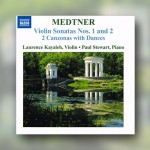
- Sonata for violin and piano No. 2 in G major, Op. 44 : (III) Finale (Rondo) : Allegro risoluto // 6 - Nikolaï Medtner - Vol. 2
- Sonata for violin and piano No. 2 in G major, Op. 44 : (II) Tema con variazioni (variation 6) :
Allegro risoluto // 6 - Nikolaï Medtner - Vol. 2 - Sonata for violin and piano No. 2 in G major, Op. 44 : (I) Allegro appassionato // 6 - Nikolaï Medtner - Vol. 2
- Sonata for violin and piano No. 1 in B minor, Op. 21 : (II) Danza: Allegro scherzando // 6 - Nikolaï Medtner - Vol. 2
- Canzona No. 2 in B minor, Op. 43 – Andantino cantabile // 6 - Nikolaï Medtner - Vol. 2



